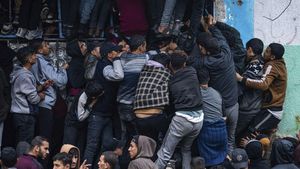Unauthorized drone flights over several U.S. military bases located across the United Kingdom have sparked growing concern among authorities and the public alike. Incidents at places like RAF Lakenheath, RAF Mildenhall, RAF Feltwell, and RAF Fairford, started attracting attention following reports last week of unidentified small unmanned aerial vehicles (UAVs) spotted hovering over these strategic installations.
These aircraft sightings were reported to have occurred between November 20 and November 25, culminating in multiple sightings over the weekend. This has raised alarms, prompting both U.K. and U.S. defense officials to take action
RAF Brize Norton has led the call for public vigilance, insisting residents report any unusual drone activity within the designated Flight Restriction Zones. "Within this area, it is illegal to fly any Uncrewed Aerial System without permission from Air Traffic Control or Station Operations," the RAF stated on their official channels.
Confirming reports, the U.S. Air Forces have indicated their installations are under close monitoring. The incidents didn’t place base facilities or personnel at risk, authorities say, but the ambiguity surrounding the drone operators is troubling. This shift to unauthorized airspace use around military bases is considered particularly alarming due to its potential security ramifications.
This situation has not only involved local military but has also drawn the U.K. Ministry of Defence's attention. Approximately 60 British personnel, including specialized counter-drone teams, have joined forces with U.S. Air Force units to launch investigations. They are collectively exploring the origins of these drone flights to determine if they signify any hostile actions.
Maria Eagle, the U.K. Defence Minister, has made bold declarations surrounding these incidents, promising full legal repercussions for those found responsible for illegal drone activity. This zero-tolerance stance echoes the sentiments expressed by military officials concerning the safeguarding of sensitive installations, which host advanced combat aircraft like F-35A fighters and B-52 Stratofortress bombers.
Apart from military personnel, the Civil Aviation Authority (CAA) has issued clear guidelines, reinforcing the legality of flight restrictions near the airbases. CAA spokespersons have stressed the importance of adhering strictly to these regulations, enhancing the security measures already undertaken by the military.
Adding fuel to the fire, various reports have suggested these drone sightings may not merely be benign or harmless civilian flights. The linking of drone activities to potential foreign surveillance has become part of the narrative, with some officials drawing parallels to similar incursions reported at military installations globally, including those potentially connected to geopolitical rivalries.
On the U.S. side, these incidents have accumulated significant media attention, particularly as they coincide with heightened fears surrounding national security. The U.S. Air Force communicated their commitment to proactively addressing airspace violations, insisting they maintain strict protocols. While some reports have suggested observing similar drones at other bases without definitive conclusions about their origin, it’s evident the spotlight is firmly fixed on aviation oversight.
The discussions around these incidents aren’t just limited to military circles. A few days ago, during congressional hearings discussing Unidentified Anomalous Phenomena (UAP), former defense officials testified about advanced technologies not solely limited to government hands. Luis Elizondo, who has worked with UAP investigations, mentioned, "we are likely witnessing a multi-decade arms race tied to technologies unknown to the public, and part of this includes monitoring military installations globally.”
The media reactions have varied; many reports started surfacing, hinting at links between these drones and broader military surveillance issues. Some have taken to social media platforms expressing speculations around whether these incidents hint at UAP interactions. Yet, officials have clarified the nature of these encounters, emphasizing the need to separate blatant drone sightings from more arcane, unidentified aerial phenomena.
Even within these discussions, experts remind the public and authorities alike to separate sensational accusations from actual evidence. Concerns were raised about unnecessary panic created through speculation, especially surrounding drone capabilities and their potential operational links to adversaries.
Consequently, the focus must shift to ensuring these zones are correctly monitored and safeguarded. Residents are urged to remain alert, reporting any suspicious aerial activities directly to local authorities to help maintain base security. The public’s engagement is expected to be pivotal during this tense period when unidentified aircraft are invading airspaces once thought secure.
Overall, the situation surrounding unauthorized drone operations over U.S. military bases in the U.K. continues to evolve, demanding swift, well-coordinated responses from military and civil agencies alike. The priority remains clear: protect sensitive military assets and unravel the mystery behind these incursions.
Only time will tell how this drone activity will influence how aerial violations are managed, but one thing is for certain: these incidents are raising eyebrows not just within military structures but also among policymakers and community members anxious about national security.



